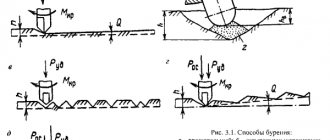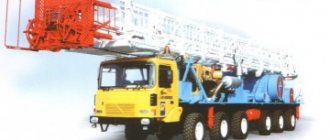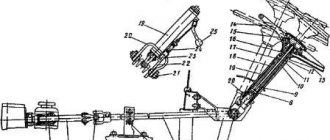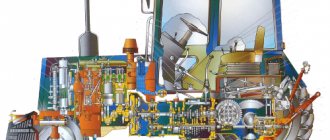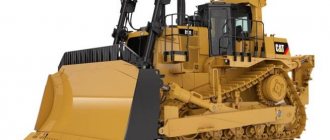Long gone are the days when laying communications was associated only with digging trenches, and in order to lay a pipe, it was necessary to tear up half the site. Trenchless laying technology allows you to get by with “little loss”; Due to this, horizontal directional drilling (HDD) is becoming an increasingly popular service. We understand the features and advantages of the technology, as well as the technical and financial aspects of drilling.
Laying a large diameter pipeline Source gnb-mos.ru
What problems does the technology solve?
Increasingly, situations arise when the classic (with digging of trenches) laying of communications is undesirable or impossible. In these cases, the HDD method comes to the rescue with its special drilling rigs, which make it possible not to disturb the top layer of soil. The technology is used to lay the following types of communications:
- Water supply (including for transporting drinking water).
- High pressure gas pipeline.
- Heating networks.
- Gravity sewerage.
- Electrical cables.
- Cases for communication cables, telephone and fiber-optic communication lines.
- Replacement of outdated communications.
- Formation of underground passages of any degree of complexity.
Schematic representation of a puncture (gasket) Source forward-gnb.ru
Pros and cons of technology
- The type of soil, landscape and its structure, the presence of reservoirs do not interfere with the process of horizontal drilling. Crowded urban buildings, congested roads or protected natural and cultural areas - this method of laying communications will not harm their condition;
- Less time and effort is spent on obtaining permits for work, since there is no need to block the movement of road and rail transport;
- The costs of attracting heavy equipment and workers to carry out large-scale earthworks are reduced;
- By attracting professional performers and high-tech installations, installation time is minimized;
- The autonomy of drilling complexes eliminates dependence on external power sources;
- HDD can be successfully carried out with high groundwater levels. They do not affect the speed and duration of work;
- About HDD we can conclude that this is minimal harm to nature and humans.
Advantages and disadvantages of the method
The revolutionary method of horizontal drilling for laying communications was developed in the 70s of the last century by the American engineer Martin Cherrington. For half a century, the technology has developed and improved, and today its following advantages are known:
- Work can be carried out in any place: in the historical center of the city, under densely populated areas, under roads and railways, buildings and water barriers, building structures and sites.
- HDD is carried out at any time of the year.
- There is no risk to other utility networks; obstacles on the surface (buildings, plants) can be ignored.
- The technology is environmentally friendly. It does not affect ground objects or road surfaces; the landscape remains intact (which is important for suburban areas).
- Compared to the open method, the speed of laying communications is higher and takes less time. You don’t have to dismantle the fence, cut down currant bushes, or spoil the lawn.
- Networks laid using the HDD method have an increased service life, and there is no ground settlement, a common occurrence when digging trenches.
The HDD method causes minimal damage to the environment Source albena.by
The HDD method has two significant disadvantages:
- If you need to lay communications over a long distance or at a considerable depth, it will cost more than the traditional method.
- For standard equipment, the maximum range does not exceed 350-400 m. If a longer route is planned, joints will have to be made.
Purpose and characteristics of the drilling rig
The HDD drilling rig allows you to replace the trench (open) method of laying communications with a more aesthetic and cost-effective trenchless method. By piercing the soil at a given depth, such a machine leaves the surface untouched, which is especially important if you need to lay communications under a building, under a roadway (route), stream or river. In this case, the trenchless HDD method will be the only option.
Thus, a horizontal drilling rig will be useful to construction companies, housing and communal services enterprises, oil and gas companies and other organizations that are engaged in laying pipelines or cable lines. When used correctly, this technique pays for itself in no more than three years. It is only important to choose the right type of machine depending on the intended work - the maximum length and diameter of drilling.
What equipment is involved?
Horizontal directional drilling is a complex technology, so the work involves a variety of drilling equipment and specialized materials. The standard set of equipment is as follows:
- HDD installation (drilling machine). Specialized equipment with rod feeder and control panel. The chassis can be tracked or wheeled and is powered by a diesel engine. The main characteristic: maximum broaching force, drilling length and expansion diameter are also important.
- Mini installations Compact HDDs cope well with installation in hard-to-reach places, but have a reduced service life. The capabilities are limited to a puncture length of up to 100 m, and the traction force does not exceed 50 tons.
Compact installation for directional horizontal drilling Source vodoseti.ru
See also: Catalog of companies that specialize in engineering systems (heating, water supply, sewerage and others) and related work
- Control system. Drilling must be carried out under constant supervision, and for this purpose a locating probe is used. It is located on the drill head, and its movement is tracked using a locator. The detector records the operating parameters of the process: angle and direction of drilling, temperature of the working area, drill speed.
- Drilling fluids. They facilitate the drilling process and affect the productivity and efficiency of work. The choice of flushing liquid depends on the quality and composition of the soil. Sandy soils intensively absorb water, clay soils swell and stick to the drill. To prevent breakdowns and delays, bentonite drilling fluids with various additives and stabilizers are used.
- Copper-graphite grease. It is needed for processing dynamic parts and threaded connections of drill rods to prevent jamming. Modern lubricating compounds have the form of a thick, flowing paste; include petroleum oils, graphite and copper powders, lithium stearate, improving additives.
Drilling fluid makes the drilling process efficient Source rusgnb.ru
- Auxiliary tool. To organize HDD drilling, the technology requires devices that help push (pierce) the soil. These are a variety of expanders, rods, and a motor pump that removes drilling fluid.
Principle of operation
The activity of a drilling rig for horizontal well construction takes place in several stages:
- Setting up a pilot well is the most difficult and important part of the work. Here the drill head must make a rough channel, determining the direction of the passage, its depth and length:
- The built-in emitter makes it possible to locate its location to control movement when changing the bevel of the drill blade from the operator's control panel.
- A drive rod for communication with the drill head and remote drilling control is also used to supply fluid to the end of the hole. The natural bending of the rod allows you to bypass obstacles, and the erosion of the soil by liquid facilitates the process, increases its speed and makes it possible to evacuate soil layers from the resulting channel. Also, the use of liquid eliminates collapses and ensures cooling of the working tool.
- Control takes place with the simultaneous operation of the location system. When moving away from the planned trajectory and obstacles appear (unbreakable stones, etc.), the work stops, turns to a given angle, and then drilling resumes.
- The expansion of the pilot hole occurs with the help of a reverse expander - a rimmer, when the working tool moves through the tunnel in the opposite direction (the rimmer is installed instead of the drill head). In this case, expansion occurs when the diameter of the hole is 1.5-2 times greater than the diameter of the installed pipe.
- Pipeline pulling takes place simultaneously with expansion work: the pipe is attached to the rimmer through a device that prevents it from rotating with it, and when the rod moves back, it enters the well.
Sequence of work performed by HDD installation
ATTENTION! Drilling using a HDD installation is carried out only after reconnaissance work to study the quality of the soil and the presence of natural and artificially created obstacles.
Stages of HDD
A company engaged in trenchless installation of communications works in strict accordance with regulatory and technical documentation (for example, in Moscow this is TSN 40-303-2003) and regulations. HDD technology involves going through the following stages:
- Selection of route and preparation of design documentation. Within the work area, the location of underground communications is being clarified. The optimal laying route is selected taking into account these data, as well as the characteristics of the soil (geological research is carried out).
- Preparation. It is necessary to prepare the site for the drilling rig: level the ground, provide lighting, determine access routes.
Main stages of HDD Source moyaskvazhina.ru
Let's start drilling - important stages of preparation
Do-it-yourself horizontal drilling involves making a puncture using professional equipment. Before you start making a channel under a road or railway tracks, you should prepare for this process. To obtain a drilled hole, it is necessary to level the site on which the equipment will be placed.
The size of the site on which the installation will be placed must be at least 10x15 m. The site is made exactly at the site of the planned puncture under the road. Only after the site of the required size has been prepared can the corresponding equipment and equipment be transported.
After placing the equipment, the anchor installation procedure is carried out, which is implemented using augers. After the anchoring procedure, the process of adjusting the angle of entry of the drill into the ground is carried out.
It is also necessary to first prepare an installation that prepares the bentonite solution. This solution is mixed by a special machine, which should be placed next to the drilling mechanism. The distance between these devices must be at least 10 meters. A bentonite solution is used to strengthen the walls of the well, as well as to remove soil from the channel being drilled.
The preparatory process also includes the following activities:
- Construction of special pits at the entrance and exit of the canal. Excessive amounts of solution will move into these wells.
- Determine the presence of underground communications that should not be affected by the drilling rig.
- Study the nature of the soil, on the basis of which a decision will be made to select the optimal route for drilling.
- Set up communication between the foreman and the equipment operator.
How the process itself will go depends on the preparation stage, so this event should be treated with particular importance. When drilling, safety precautions are observed, on which the health and life of workers depends.
Video description
How HDD technology works in the following video:
- Construction of a working well. To expand the well to the desired diameter, it may take from 1 to 3 consecutive passes of the reamer (in this case, it is changed each time to a device of a larger diameter). The number of passes depends on the characteristics of the installation and soil parameters.
- The diameter of the finished well is 25-30% greater than the diameter of the pipeline.
- Pipe pulling. Using special fasteners and clamps, the string of pipes is pulled into the well. In long wells, the force for tightening the pipes is created by the drilling rig, which also lays the pipe correctly. If the well is small-sized, lined with polymer pipes, installation can be done manually.
Pulling pipes under the road Source wixstatic.com
Pipeline laying
Now let's look at what the method of laying pipes into a prepared hole is. For this, swivels and brackets are used that are attached to the pipe. It is these elements that are the basis for fastening and fixing the pipeline, due to which the pipe is pulled into the channel.
To fix the pipe using a swivel, a special head is fixed to its beginning. Drilling strings are attached to this head. If the well is small-sized, into which it is planned to tighten polymer pipes, then tightening is done with your own hands or using the forces of drilling machines. As soon as the pipe is pulled into the channel, the GB process can be considered complete.
A horizontal puncture is a responsible undertaking that should be thought through from start to finish. Initially, a project is prepared, on the basis of which the optimal location is selected. Only after the project is ready can the implementation of the process begin.
Briefly about the main thing
Horizontal directional drilling allows you to bypass any obstacles without extra costs and preserve the landscape on the site. Before starting work, a careful analysis of the territory, existing communications and soil is carried out; this allows you to select the right tools and materials.
At the first stage, a pilot well is prepared. Its task is to outline the trajectory for laying communications. Betonite is fed into the well through special holes; it strengthens the soil and brings remaining soil to the surface. Then the well is expanded to the required diameter and a pre-prepared pipeline string is pulled through, monitoring the correct installation.
Important points when drilling
When drilling a well, you need to take into account such a factor as soil shedding. Both plastic and steel pipes can be pulled into the channel. It is only important to take into account one criterion: plastic can be laid under a bend, for example, when punctured under a reservoir, and metal pipelines must be laid only in an exclusively horizontal direction.
When pulling pipes into a well, they should be connected. Moreover, the connection must be as reliable as possible, otherwise problems with the sewage system cannot be avoided later. Docking with the annular expander rods is performed with the equipment turned off. Through a swivel that rotates, communications are connected. Special adapters are used for joining.
The channel must be 25% larger than the size of the pipeline laid in it. If you plan to lay a pipe with thermal insulation materials, then the channel needs to be expanded by 50%.
If the pressure in the channel is high, then the bentonite solution is distributed evenly, thereby filling the space between the outer walls of the pipes and the inside of the channel. After the solution hardens, the possibility of soil subsidence is completely eliminated.

